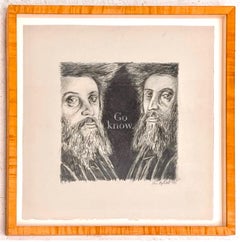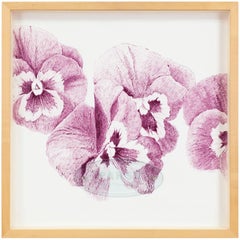Jacob Cooley
Late 20th Century Conceptual Mixed Media
Paper, Film, Graphite, Pigment
Late 20th Century Conceptual Mixed Media
Glass, Ink
Recent Sales
Late 20th Century Conceptual Mixed Media
Glass, Ink
A Close Look at conceptual Art
In 1967, artist Sol LeWitt wrote that in “Conceptual art the idea or concept is the most important aspect of the work.” He was giving a name to an art movement that had emerged in the 1960s in which artists were less focused on their medium being something traditionally “artistic” and instead engaged in using any object, movement, form, action or place to express an idea.
LeWitt’s work was featured alongside an assemblage of notes, drawings and outlines by other artists in “Working Drawings and Other Visible Things on Paper Not Necessarily Meant to Be Viewed as Art,” a groundbreaking show at New York City’s School of Visual Arts curated by Mel Bochner, another leading exponent of Conceptualism. Building on radical 20th-century statements, like Fountain (1917) by French artist Marcel Duchamp, Conceptual artists around Europe and North and South America were not interested in the commercial art scene and rather directly challenged its systems and values.
Stretching into the 1970s, this movement has also been called Post-Object art and Dematerialized art. Conceptual art reflected a larger era of social and political upheaval. Pieces associated with the style range from Roelof Louw’s Soul City (Pyramid of Oranges) (1967) — a work of installation art that sees fresh oranges stacked into a pyramid from which visitors are allowed to take one orange away — to On Kawara’s “Today” series, which saw the Japanese artist carefully painting a date in white acrylic on canvases consisting of a single color from 1966 to his death in 2014. Artists such as Ed Ruscha, who created the Twentysix Gasoline Stations book — a collection of photos of gas stations that is widely said to be the first modern artists’ book — made photography a major platform for Conceptual art, as did Bruce Nauman, who burned one of Ruscha's books and then photographed it for his own.
Conceptual art’s legacy of questioning artistic authorship, ownership and how to work with complex ideas of space and time had a significant influence on the decades of culture that followed, and it continues to inform art today.
The collection of Conceptual photography, paintings and sculptures on 1stDibs includes artworks by John Baldessari, Jenny Holzer, Lawrence Weiner, Joseph Kosuth and others.
Finding the Right Mixed Media for You
Mixed media is a type of art that sees artists using a range of materials or more than one medium. Find a range of mixed media paintings and other artworks for your space today on 1stDibs.
Mixed media is distinct from multimedia, which describes art involving electronic media, including video, computers and digital elements. Artists combine painting, drawing, photography and sculpture for mixed media art. Instead of sticking to one form, they aim to break boundaries and create unique pieces. Pop art is one of the vibrant periods for mixed media art, with Jasper Johns and Robert Rauschenberg among its most fabled producers. Rauschenberg, like many mixed media artists, used found objects in his work, from cast-off furniture to newspapers.
Collage is one of the most well-known areas of mixed media. Artists use various types of paper, fabric, photographs and more to create one cohesive work. A type of collage is assemblage, which involves 3D objects.
While artists may use fabric in collage, it can be the very substance of the art itself. Fabric art makes extensive use of texture. Artists may paint or embroider on fabric to create layers of texture and color to evoke a specific feeling. They can also transfer photos onto fabric for innovative ways to display visuals.
Resin-based art has clean, sharp lines and a definitive shape. Resin is a liquid that hardens to a high-gloss surface and is used to seal wood, counters and floors. Resin can also seal artwork, and many artists tint it using pigment powder, ink, spray paint and other vivid materials. If water is added, the resin will turn milky instead of being completely transparent. It’s common for artists working in mixed media to use resin on nontraditional surfaces like glass, wood, metal and stone. This creates a shine that’s perfect to brighten a dull space in the home or office.
Find mixed media paintings and other art for sale on 1stDibs.


